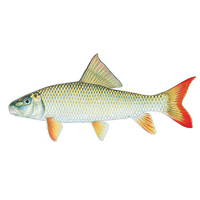River redhorse
Scientific name: Moxostoma carinatum

Cover photo credit: Joseph R. Tomelleri
Status
Special Concern
“Special Concern” means the species lives in the wild in Ontario, is not endangered or threatened, but may become threatened or endangered due to a combination of biological characteristics and identified threats.
Date added to the Species at Risk in Ontario List
The River Redhorse was previously listed as special concern. A reassessment in June 2016 confirmed this status.
Read the assessment report (PDF)
What it looks like
The River redhorse is a large, thick-bodied sucker with a large, flat-topped head, a prominent snout and a red-tinted tail fin. It has a white belly, brown or olive green back and brassy, yellowish-green or coppery sides. It can grow to a size nearing 80 centimetres and weigh more than 5.5 kilograms.
Where it lives
The River redhorse inhabits medium to large-size rivers that have substantial flows. In May and June, adults migrate from deeper, slower moving pools and run habitats to shallow riffle-run habitats having coarse substrate and moderate to swift flow.
Where it’s been found in Ontario
The River redhorse lives in scattered locations through central and eastern North America including Ontario and Quebec. In Ontario, it has been found in the Bay of Quinte, and the Trent, Grand, Thames, Ottawa, Mississippi, and Madawaska rivers.
View a larger version of this map (PDF)
What threatens it
The River redhorse requires clear and unpolluted water and is therefore susceptible to siltation and turbidity that can result from farming and urban development. Dams are also a threat as they can alter habitat conditions and prevent migrating fish from reaching traditional breeding areas or other important habitats.
Action we are taking
Special concern species do not receive species or habitat protection.
What you can do
Report a sighting
- Report a sighting of an endangered animal or plant to the Natural Heritage Information Centre. Photographs with specific locations or mapping coordinates are always helpful.
Volunteer
Volunteer with your local nature club or provincial park to participate in surveys or stewardship work focused on species at risk.
Be a good steward
- private land owners have a very important role to play in species recovery; you may be eligible for stewardship programs that support the protection and recovery of species at risk and their habitats
- land owners can help improve fish habitat and keep Ontario’s water safe and clean by maintaining natural vegetation next to creeks and rivers, and keeping pollution and soil from washing into Ontario’s rivers; you can find more information about programs and funding assistance for eligible farmers from the Ontario Soil and Crop Improvement Association website
Report illegal activity
Report any illegal activity related to plants and wildlife to 1-877-TIPS-MNR (847-7667).
Quick facts
- the River redhorse is one of six species of redhorse in Ontario, which can be difficult to tell apart; to help separate the six species, biologists look closely at the number of scales along their sides and around their tail, features of their lips and the colour of their tail
- the maximum age reported for River redhorse in Canada is 28 years
- the bottom-feeding River redhorse uses its fleshy lips, highly charged with nerve endings, to feel for food along river beds; the River redhorse does not have teeth on its jaw but rather uses molar-like teeth in its throat to crush its food
- River redhorse males construct nests in clean gravel by sweeping with their tail, carrying rocks with their mouths or moving the underlying material with their heads; the nests are excavated to a depth of 20 to 30 centimetres and may be up to 1.2 to 2.4 metres across
